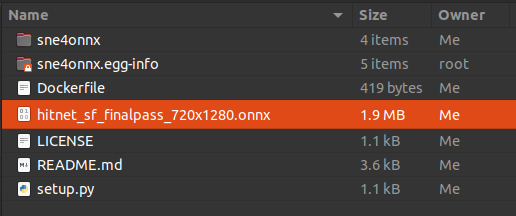PyTorch Infer Utils
This package proposes simplified exporting pytorch models to ONNX and TensorRT, and also gives some base interface for model inference.
To install
git clone https://github.com/gorodnitskiy/pytorch_infer_utils.git
pip install /path/to/pytorch_infer_utils/
Export PyTorch model to ONNX
- Check model for denormal weights to achieve better performance. Use
load_weights_rounded_modelfunc to load model with weights rounding:from pytorch_infer_utils import load_weights_rounded_model model = ModelClass() load_weights_rounded_model( model, "/path/to/model_state_dict", map_location=map_location ) - Use
ONNXExporter.torch2onnxmethod to export pytorch model to ONNX:from pytorch_infer_utils import ONNXExporter model = ModelClass() model.load_state_dict( torch.load("/path/to/model_state_dict", map_location=map_location) ) model.eval() exporter = ONNXExporter() input_shapes = [-1, 3, 224, 224] # -1 means that is dynamic shape exporter.torch2onnx(model, "/path/to/model.onnx", input_shapes) - Use
ONNXExporter.optimize_onnxmethod to optimize ONNX via onnxoptimizer:from pytorch_infer_utils import ONNXExporter exporter = ONNXExporter() exporter.optimize_onnx("/path/to/model.onnx", "/path/to/optimized_model.onnx") - Use
ONNXExporter.optimize_onnx_simmethod to optimize ONNX via onnx-simplifier. Be careful with onnx-simplifier not to lose dynamic shapes.from pytorch_infer_utils import ONNXExporter exporter = ONNXExporter() exporter.optimize_onnx_sim("/path/to/model.onnx", "/path/to/optimized_model.onnx") - Also, a method combined the above methods is available
ONNXExporter.torch2optimized_onnx:from pytorch_infer_utils import ONNXExporter model = ModelClass() model.load_state_dict( torch.load("/path/to/model_state_dict", map_location=map_location) ) model.eval() exporter = ONNXExporter() input_shapes = [-1, 3, -1, -1] # -1 means that is dynamic shape exporter.torch2optimized_onnx(model, "/path/to/model.onnx", input_shapes) - Other params that can be used in class initialization:
- default_shapes: default shapes if dimension is dynamic, default = [1, 3, 224, 224]
- onnx_export_params:
- export_params: store the trained parameter weights inside the model file, default = True
- do_constant_folding: whether to execute constant folding for optimization, default = True
- input_names: the model's input names, default = ["input"]
- output_names: the model's output names, default = ["output"]
- opset_version: the ONNX version to export the model to, default = 11
- onnx_optimize_params:
- fixed_point: use fixed point, default = False
- passes: optimization passes, default = [ "eliminate_deadend", "eliminate_duplicate_initializer", "eliminate_identity", "eliminate_if_with_const_cond", "eliminate_nop_cast", "eliminate_nop_dropout", "eliminate_nop_flatten", "eliminate_nop_monotone_argmax", "eliminate_nop_pad", "eliminate_nop_transpose", "eliminate_unused_initializer", "extract_constant_to_initializer", "fuse_add_bias_into_conv", "fuse_bn_into_conv", "fuse_consecutive_concats", "fuse_consecutive_log_softmax", "fuse_consecutive_reduce_unsqueeze", "fuse_consecutive_squeezes", "fuse_consecutive_transposes", "fuse_matmul_add_bias_into_gemm", "fuse_pad_into_conv", "fuse_transpose_into_gemm", "lift_lexical_references", "nop" ]
Export ONNX to TensorRT
- Check TensorRT health via
check_tensorrt_healthfunc - Use
TRTEngineBuilder.build_enginemethod to export ONNX to TensorRT:from pytorch_infer_utils import TRTEngineBuilder exporter = TRTEngineBuilder() # get engine by itself engine = exporter.build_engine("/path/to/model.onnx") # or save engine to /path/to/model.trt exporter.build_engine("/path/to/model.onnx", engine_path="/path/to/model.trt") - fp16_mode is available:
from pytorch_infer_utils import TRTEngineBuilder exporter = TRTEngineBuilder() engine = exporter.build_engine("/path/to/model.onnx", fp16_mode=True) - int8_mode is available. It requires calibration_set of images as
List[Any],load_image_func- func to correctly read and process images,max_image_shape- max image size as [C, H, W] to allocate correct size of memory:from pytorch_infer_utils import TRTEngineBuilder exporter = TRTEngineBuilder() engine = exporter.build_engine( "/path/to/model.onnx", int8_mode=True, calibration_set=calibration_set, max_image_shape=max_image_shape, load_image_func=load_image_func, ) - Also, additional params for builder config
builder.create_builder_configcan be put to kwargs. - Other params that can be used in class initialization:
- opt_shape_dict: optimal shapes, default = {'input': [[1, 3, 224, 224], [1, 3, 224, 224], [1, 3, 224, 224]]}
- max_workspace_size: max workspace size, default = [1, 30]
- stream_batch_size: batch size for forward network during transferring to int8, default = 100
- cache_file: int8_mode cache filename, default = "model.trt.int8calibration"
Inference via onnxruntime on CPU and onnx_tensort on GPU
- Base class ONNXWrapper
__init__has the structure as below:def __init__( self, onnx_path: str, gpu_device_id: Optional[int] = None, intra_op_num_threads: Optional[int] = 0, inter_op_num_threads: Optional[int] = 0, ) -> None: """ :param onnx_path: onnx-file path, required :param gpu_device_id: gpu device id to use, default = 0 :param intra_op_num_threads: ort_session_options.intra_op_num_threads, to let onnxruntime choose by itself is required 0, default = 0 :param inter_op_num_threads: ort_session_options.inter_op_num_threads, to let onnxruntime choose by itself is required 0, default = 0 :type onnx_path: str :type gpu_device_id: int :type intra_op_num_threads: int :type inter_op_num_threads: int """ if gpu_device_id is None: import onnxruntime self.is_using_tensorrt = False ort_session_options = onnxruntime.SessionOptions() ort_session_options.intra_op_num_threads = intra_op_num_threads ort_session_options.inter_op_num_threads = inter_op_num_threads self.ort_session = onnxruntime.InferenceSession( onnx_path, ort_session_options ) else: import onnx import onnx_tensorrt.backend as backend self.is_using_tensorrt = True model_proto = onnx.load(onnx_path) for gr_input in model_proto.graph.input: gr_input.type.tensor_type.shape.dim[0].dim_value = 1 self.engine = backend.prepare( model_proto, device=f"CUDA:{gpu_device_id}" ) ONNXWrapper.runmethod assumes the use of such a structure:img = self._process_img_(img) if self.is_using_tensorrt: preds = self.engine.run(img) else: ort_inputs = {self.ort_session.get_inputs()[0].name: img} preds = self.ort_session.run(None, ort_inputs) preds = self._process_preds_(preds)
Inference via onnxruntime on CPU and TensorRT on GPU
- Base class TRTWrapper
__init__has the structure as below:def __init__( self, onnx_path: Optional[str] = None, trt_path: Optional[str] = None, gpu_device_id: Optional[int] = None, intra_op_num_threads: Optional[int] = 0, inter_op_num_threads: Optional[int] = 0, fp16_mode: bool = False, ) -> None: """ :param onnx_path: onnx-file path, default = None :param trt_path: onnx-file path, default = None :param gpu_device_id: gpu device id to use, default = 0 :param intra_op_num_threads: ort_session_options.intra_op_num_threads, to let onnxruntime choose by itself is required 0, default = 0 :param inter_op_num_threads: ort_session_options.inter_op_num_threads, to let onnxruntime choose by itself is required 0, default = 0 :param fp16_mode: use fp16_mode if class initializes only with onnx_path on GPU, default = False :type onnx_path: str :type trt_path: str :type gpu_device_id: int :type intra_op_num_threads: int :type inter_op_num_threads: int :type fp16_mode: bool """ if gpu_device_id is None: import onnxruntime self.is_using_tensorrt = False ort_session_options = onnxruntime.SessionOptions() ort_session_options.intra_op_num_threads = intra_op_num_threads ort_session_options.inter_op_num_threads = inter_op_num_threads self.ort_session = onnxruntime.InferenceSession( onnx_path, ort_session_options ) else: self.is_using_tensorrt = True if trt_path is None: builder = TRTEngineBuilder() trt_path = builder.build_engine(onnx_path, fp16_mode=fp16_mode) self.trt_session = TRTRunWrapper(trt_path) TRTWrapper.runmethod assumes the use of such a structure:img = self._process_img_(img) if self.is_using_tensorrt: preds = self.trt_session.run(img) else: ort_inputs = {self.ort_session.get_inputs()[0].name: img} preds = self.ort_session.run(None, ort_inputs) preds = self._process_preds_(preds)
Environment
TensorRT
- TensorRT installing guide is here
- Required CUDA-Runtime, CUDA-ToolKit
- Also, required additional python packages not included to
setup.cfg(it depends upon CUDA environment version):- pycuda
- nvidia-tensorrt
- nvidia-pyindex
onnx_tensorrt
- onnx_tensorrt requires cuda-runtime and tensorrt.
- To install:
git clone --depth 1 --branch 21.02 https://github.com/onnx/onnx-tensorrt.git cd onnx-tensorrt cp -r onnx_tensorrt /usr/local/lib/python3.8/dist-packages cd .. rm -rf onnx-tensorrt





